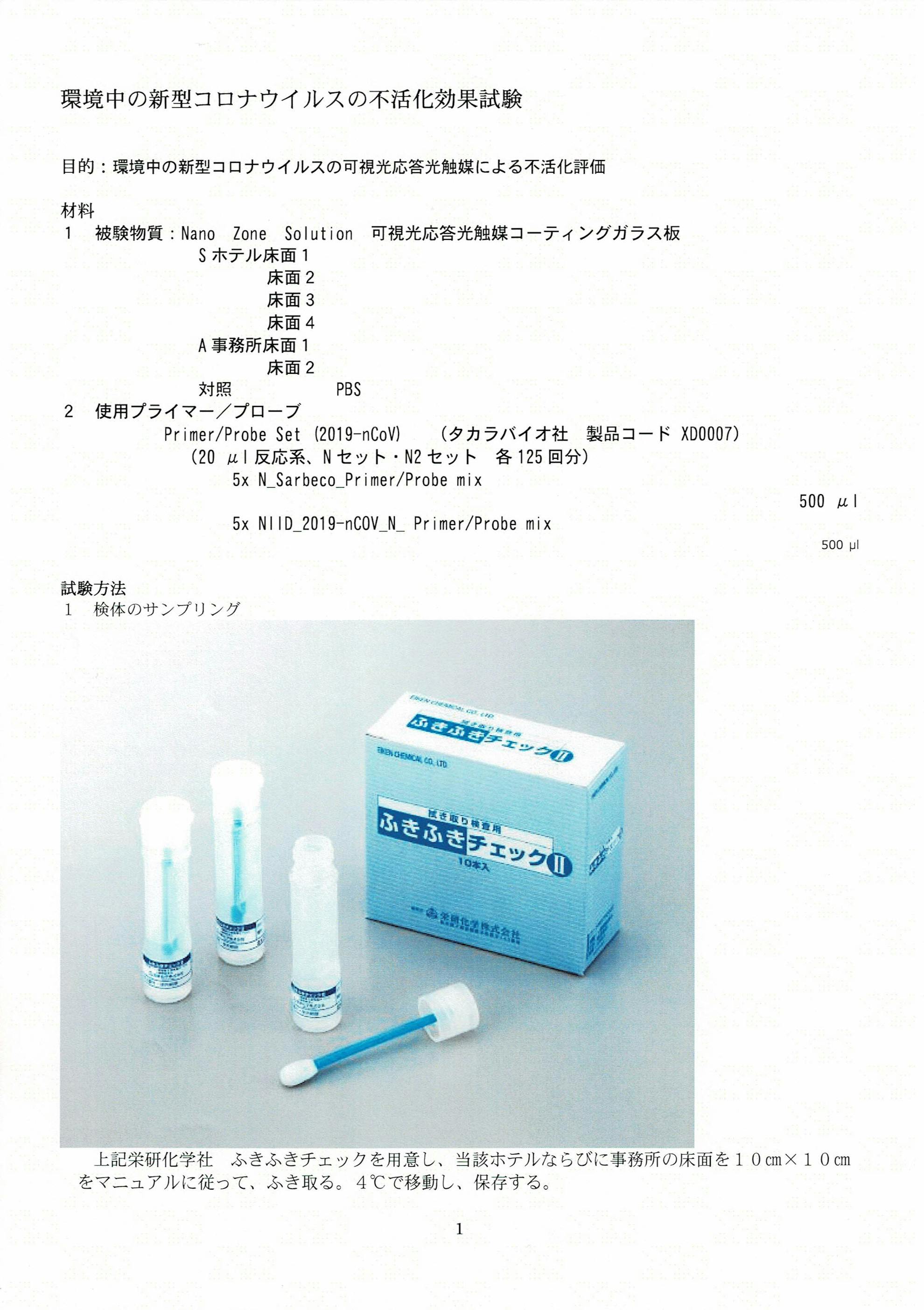

環境中の新型コロナウイルスの不活化効果試験
Inactivation effect test of a new coronavirus
*TEST By: Biomedical Sciences Research Group (Narashino Research Institute)
Reported by Mikio Mizuno date; 2020 Oct. 26
目的:環境中の新型コロナウイルスの可視光応答光触媒による不活化評価
Evaluation of Inactivation of new coronavirus in the environment by visible light-responsive photocatalysts
材料
Sホテル床面1 Hotel Floor 1
床面2 Floor 2
床面3 Floor 3
床面4 Floor 4
A事務所床面1 Office Floor 1
床面2 Floor 2
対照 PBS contract
Takara Bio Product XD0007
(20 n I反応系、Nセット• N2セット 各125回分)
5x N_Sarbeco_Primer/Probe mix
500 n\
5x NlID_2019-nC0V_N_ Primer/Probe mix
500 pl
試験方法 Test method
1検体のサンプリング Sampling
上記栄研化学社 ふきふきチェックを用意し、当該ホテルならびに事務所の床面を1OcmX1Ocm をマニュアルに従って、ふき取る。4°Cで移動し、保存する。
Prepare the above Eiken Chemical Co., Ltd. wipe-off test. Wipe the floor of the hotel and office with 10cmX10cm in accordance with the manual. Move and save at 4 degrees C.
環境中より採取した新型コロナウイルス(SARS-CoV-2)検体に対する光触媒材料の効果評価
valuation of the effect of photocatalytic materials on new coronavirus (SARS-CoV-2) samples collected from the environment
試験目的:環境中より採取した新型コロナウイルス(SARS-CoV-2)検体に対する光触媒材料の効果評価を行う。
Test objective: To evaluate the effect of photocatalytic materials on new coronavirus (SARS-CoV-2) samples collected from the environment.
試験材料
1.被験物質(サンプル):nanozone SOLUTIONをホウケイ酸ガラスに塗布した光触媒検体
Test substance (sample): photocatalyst sample with nanozone SOLUTION applied to borosilicate glass
Sample: nanozeon COAT (solution) coating on Rotating glass plate
2 .使用ウイルス:環境中より採取
Viruses used: collected from the environment
試験方法
JIS R 1702 準拠
Test method JIS R 1702
(1) New coronavirus (SARS-CoV-2) environmental specimens were performed PCR test and Nested PCR test in accordance with the official Japanese law of the National Institute of Infectious Diseases.
The results are shown in the table below 使用検体
Specimens to be used新型コロナウイルス(SARS-CoV-2)環境検体
New Coronavirus (SARS-CoV-2) Environmental Specimen光触媒
photocatalystnanozone SOLUTION コーティング光触媒
Nanozone solution (COAT); coated glass plate 対照
Comparison contrastコーティングしていないガラスプレート
Un-coated glass plate 30分間
After 30min. irradiation検出限界以下
Below the detection limit
考察: study
環境中より採取した新型コロナウイルス(SARS-CoV-2)検体について、nanozone SOLUTIONで光触媒コーティングした光触媒担体で処理すると、環境中より採取した新型コロナウイルス(SARS-CoV-2)検 体は、LED光源下照射後には瞬時に分解がはじまりPCRならびにNested PCRで30分後には検出限界以 下となった。これにより環境中より採取した新型コロナウイルス(SARS-CoV-2)のRNAは可視光応答型 光触媒によって分解され、抗ウイルス活性として認められた。
For the new coronavirus (SARS-CoV-2) sample collected from the environment, when processed with a photocatalytic carrier photocatalyst coated with nanozone SOLUTION, new coronavirus collected from the environment (SARS-CoV-2) analyzer begins to decompose instantaneously after irradiation under LED light source. In PCR and Nested PCR, it was below the detection limit after 30 minutes. Thus RNA of the new coronavirus collected from the environment (SARS-CoV-2) is degraded by visible light-responsive photocatalyst, it was observed as antiviral activity.
Inactivation effect test of a new coronavirus
*TEST By: Biomedical Sciences Research Group (Narashino Research Institute)
Reported by Mikio Mizuno date; 2020 Oct. 26
目的:環境中の新型コロナウイルスの可視光応答光触媒による不活化評価
Evaluation of Inactivation of new coronavirus in the environment by visible light-responsive photocatalysts
材料
- 被験物質:Nano Zone Solution可視光応答光触媒ローティングガラス板
Sホテル床面1 Hotel Floor 1
床面2 Floor 2
床面3 Floor 3
床面4 Floor 4
A事務所床面1 Office Floor 1
床面2 Floor 2
対照 PBS contract
- 使用プライマー/プローブ
Takara Bio Product XD0007
(20 n I反応系、Nセット• N2セット 各125回分)
5x N_Sarbeco_Primer/Probe mix
500 n\
5x NlID_2019-nC0V_N_ Primer/Probe mix
500 pl
試験方法 Test method
1検体のサンプリング Sampling
上記栄研化学社 ふきふきチェックを用意し、当該ホテルならびに事務所の床面を1OcmX1Ocm をマニュアルに従って、ふき取る。4°Cで移動し、保存する。
Prepare the above Eiken Chemical Co., Ltd. wipe-off test. Wipe the floor of the hotel and office with 10cmX10cm in accordance with the manual. Move and save at 4 degrees C.
環境中より採取した新型コロナウイルス(SARS-CoV-2)検体に対する光触媒材料の効果評価
valuation of the effect of photocatalytic materials on new coronavirus (SARS-CoV-2) samples collected from the environment
試験目的:環境中より採取した新型コロナウイルス(SARS-CoV-2)検体に対する光触媒材料の効果評価を行う。
Test objective: To evaluate the effect of photocatalytic materials on new coronavirus (SARS-CoV-2) samples collected from the environment.
試験材料
1.被験物質(サンプル):nanozone SOLUTIONをホウケイ酸ガラスに塗布した光触媒検体
Test substance (sample): photocatalyst sample with nanozone SOLUTION applied to borosilicate glass
Sample: nanozeon COAT (solution) coating on Rotating glass plate
2 .使用ウイルス:環境中より採取
Viruses used: collected from the environment
試験方法
JIS R 1702 準拠
Test method JIS R 1702
- 新型コロナウイルス(SARS-CoV-2)環境検体は、国立感染症研究所の公定法にしたがってPCR検査• Nested
(1) New coronavirus (SARS-CoV-2) environmental specimens were performed PCR test and Nested PCR test in accordance with the official Japanese law of the National Institute of Infectious Diseases.
- nanozone SOLUTIONで光触媒コーティングしたガラスプレート5cm X 5cmにLED光源下l,000Lx にて30分間照射した。(2) The glass plate 5cm x 5cm photocatalyst coated with nanozone SOLUTION was irradiated for 30 minutes with LED light source l, 000Lx.
- その後、PCRならびにNested PCRで電気泳動法にて解析した。
- (3) After that, it was analyzed by electrophoresis by PCR and Nested PCR.
- After lighting, the laboratory analyzed by PCR and Nested PCR by electrophoresis.
The results are shown in the table below 使用検体
Specimens to be used新型コロナウイルス(SARS-CoV-2)環境検体
New Coronavirus (SARS-CoV-2) Environmental Specimen光触媒
photocatalystnanozone SOLUTION コーティング光触媒
Nanozone solution (COAT); coated glass plate 対照
Comparison contrastコーティングしていないガラスプレート
Un-coated glass plate 30分間
After 30min. irradiation検出限界以下
Below the detection limit
考察: study
環境中より採取した新型コロナウイルス(SARS-CoV-2)検体について、nanozone SOLUTIONで光触媒コーティングした光触媒担体で処理すると、環境中より採取した新型コロナウイルス(SARS-CoV-2)検 体は、LED光源下照射後には瞬時に分解がはじまりPCRならびにNested PCRで30分後には検出限界以 下となった。これにより環境中より採取した新型コロナウイルス(SARS-CoV-2)のRNAは可視光応答型 光触媒によって分解され、抗ウイルス活性として認められた。
For the new coronavirus (SARS-CoV-2) sample collected from the environment, when processed with a photocatalytic carrier photocatalyst coated with nanozone SOLUTION, new coronavirus collected from the environment (SARS-CoV-2) analyzer begins to decompose instantaneously after irradiation under LED light source. In PCR and Nested PCR, it was below the detection limit after 30 minutes. Thus RNA of the new coronavirus collected from the environment (SARS-CoV-2) is degraded by visible light-responsive photocatalyst, it was observed as antiviral activity.
